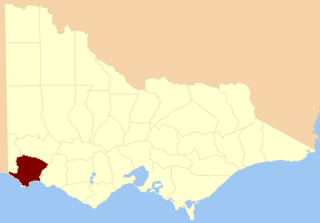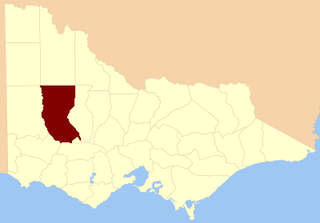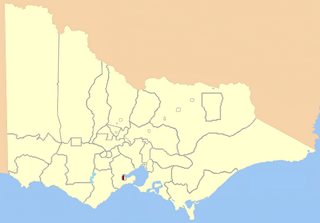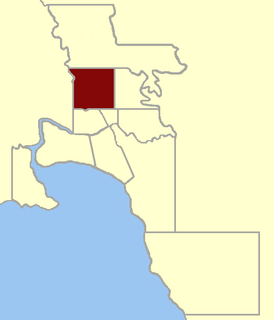Related Research Articles
The Electoral district of Wangaratta was an electoral district of the Victorian Legislative Assembly. It was created in the redistribution of 1904, the Electoral district of Wangaratta and Rutherglen being abolished.
Electoral district of Abbotsford was an electoral district of the Legislative Assembly in the Australian state of Victoria.
Melbourne West Province was an electorate of the Victorian Legislative Council from 1904 until 2006.

The Electoral district of Normanby was an electoral district in the Legislative Assembly of Victoria, it covered an area from the South Australian border to Portland Bay.
The electoral district of Allandale was an electoral district of the Legislative Assembly in the Australian state of Victoria, located north-west of Ballarat.

The electoral district of Wimmera was an electoral district of the Legislative Assembly in the Australian state of Victoria.
The electoral district of Port Fairy and Glenelg was an electorate of the Victorian Legislative Assembly in the Australian state of Victoria. Created in 1927 by the amalgamation of Port Fairy and Glenelg, Ernie Bond was the last member for Glenelg and the first for Port Fairy and Glenelg. The electorate was abolished in 1945.
Northern Province was an electorate of the Victorian Legislative Council (Australia),

Western Province was an electorate of the Victorian Legislative Council (Australia), the upper house of the Parliament of Victoria. Victoria was a colony in Australia when Western Province was created. From Federation in 1901, Victoria was a state in the Commonwealth of Australia.
South Eastern Province was an electorate of the Victorian Legislative Council from November 1882. It was created in the redistribution of provinces in 1882 when the original provinces of Central and Eastern were abolished. The new South Eastern, South Yarra, North Yarra, North Eastern, North Central, Melbourne East, Melbourne North, Melbourne South and Melbourne West Provinces were then created.

Southern Province was an electorate of the Victorian Legislative Council.
Melbourne East Province was an electorate of the Victorian Legislative Council.

The electoral district of Borung was an electorate of the Victorian Legislative Assembly in the Australian colony of Victoria, which existed in two incarnations, from 1889 to 1927, and then from 1945 to 1955.

Port Fairy was an electoral district of the Legislative Assembly in the Australian state of Victoria from 1889 to 1927. It was created when the Electoral district of Belfast was renamed. Bryan O'Loghlen was the last member for Belfast, serving 1888–1889.

West Bourke was an electoral district of the Legislative Assembly in the Australian state of Victoria from 1856 to 1904.

East Bourke was an electoral district of the Legislative Assembly in the Australian state of Victoria from 1856 until being abolished by the post-Federation Electoral Districts Boundaries Act 1903 coming into effect in 1904.

Geelong East was an electoral district of the Legislative Assembly in the Australian state of Victoria from 1859 to 1985. It was located south of the city of Geelong, defined in the Victorian Electoral Act, 1858 as:
Commencing at the north-western angle of the town reserve of Geelong; thence by a line south to the River Barwon; thence westward and northwestward by the River Barwon to the western boundary of the reserve at the junction of the Moorabool and Barwon; thence east by the northern boundary of section 25, parish of Barrabool; thence south by the eastern boundaries of sections 25 and 11, and by part of the eastern boundary of section 7, all in the same parish; thence south-easterly by a curved line crossing the Waurn Chain of Ponds to the southern boundary of section 3, parish of Conewarre; thence east by the southern boundaries of sections 3 and 4 in the same parish; thence north-easterly by a curved line crossing the River Barwon to the south-eastern angle of section 11 in the parish of Moolap; thence by the eastern boundary of that section and a line north to the shores of Corio Bay; and thence by the shores of Corio Bay to the north-western angle of the town reserve, the commencing point aforesaid, including the remaining portion of the reserve at Point Henry.

Geelong West was an electoral district of the Legislative Assembly in the Australian state of Victoria from 1859 to 1985. It was located west of the city of Geelong, defined in the Victorian Electoral Act, 1858 as:
Bounded on the north and north-west by a line drawn at a distance of 2 miles from the north-western angle of the town reserve of Geelong, as a centre from the western shore of Corio Bay, near Cowie's Creek, to a road leading to the River Barwon; on the west by that road; on the south-west and south by the River Barwon; and on the east by the western boundary of the town reserve of Geelong and the shores of Corio Bay, including the reserve at the junction of the Barwon and Moorabool

North Melbourne was an electoral district of the Legislative Assembly in the Australian state of Victoria from 1859 to 1927.
Wangaratta and Rutherglen was an electoral district of the Legislative Assembly in the Australian state of Victoria from 1889 to 1904. It was located around the towns of Wangaratta and Rutherglen. When it was abolished in 1904, the new Electoral district of Wangaratta was created; John Bowser was the last member for Wangaratta and Rutherglen and the first for Wangaratta.
References
- 1 2 "Electoral Districts Boundaries Act 1903". Australasian Legal Information Institute. Retrieved 21 January 2014.
- 1 2 "Re-Member (Former Members)". State Government of Victoria. Retrieved 24 April 2013.